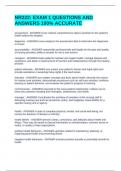NR222: EXAM 1 QUESTIONS AND
ANSWERS 100% ACCURATE
assessment - ANSWER-nurse collects comprehensive data to pertinent to the patient's
health and/or the situation
diagnosis - ANSWER-nurse analyzes the assessment data to determine the diagnoses
or issues
accountability - ANSWER-responsible professionally and legally for the type and quality
of nursing provided, ability to answer for one's own actions
caregiver - ANSWER-Helps patients maintain and regain health, manage disease and
symptoms, and attain a maximal level of function and independence through the healing
process
patient advocate - ANSWER-you protect your patient's human and legal rights and
provide assistance in asserting these rights if the need arises
educator - ANSWER-you explain concepts and facts about health, describe the reason
for routine care activities, demonstrate procedures such as self-care activities, reinforce
learning or patient behavior, and evaluate the patient's progress in learning
communicator - ANSWER-essential to the nurse-patient relationship; it allows you to
know your patients including their strengths, weaknesses, and needs
manager - ANSWER-Coordinates the activities of members of the nursing staff in
delivering nursing care and has personnel, policy, and budgetary responsibility for a
specific nursing unit or agency
health - ANSWER-A state of complete physical, mental, and social well-being, not
merely the absence of disease or infirmity
health beliefs - ANSWER-person's ideas, convictions, and attitudes about health and
illness. They may be based on factual information or misinformation, common sense or
myths, or reality or false expectations
positive health behaviors - ANSWER-activities related to maintaining, attaining, or
regaining good health and preventing illness
negative health behaviors - ANSWER-include practices actually or potentially harmful to
health
,Florence Nightingale - ANSWER-Established sanitary nursing care units. Founder of
modern nursing. began professional education of nursing.
Clara Barton - ANSWER-Nurse during the Civil War; founder of the American Red
Cross
Mother Bickerdyke - ANSWER-organized ambulance services and walked abandoned
battlefields at night, looking for wounded soldiers.
Mary Mahoney - ANSWER-First professionally trained African American nurse; brought
cultural diversity and respect
illness - ANSWER-A state in which a person's physical, emotional, intellectual, social,
developmental, or spiritual functioning is diminished or impaired
acute illness - ANSWER-reversible, has a short duration, and is often severe. The
symptoms appear abruptly, are intense, and often subside after a relatively short period
chronic illness - ANSWER-persists, usually longer than 6 months, is irreversible, and
affects functioning in one or more systems. Patients often fluctuate between maximal
functioning and serious health relapses that may be life threatening
illness behavior - ANSWER-Involves how people monitor their bodies and define and
interpret their symptoms
Lillian Wald and Mary Brewster - ANSWER-Opened the Henry Street Settlement,
focusing on the health needs of the poor
Mary Nutting - ANSWER-First Nursing professor at Columbia Teachers College.
Helped move nursing into universities.
health promotion model focuses on which 3 areas - ANSWER-(1) individual
characteristics and experiences
(2) behavior-specific knowledge and effect
(3) behavioral outcomes, in which the patient commits to or changes a behavior
health promoting behavior - ANSWER-the desired behavioral outcome and the end
point in the HPM. Health-promoting behaviors result in improved health, enhanced
functional ability, and better quality of life at all stages of development
health promotion model (HPM) - ANSWER--defines health as a positive, dynamic state,
not merely the absence of disease
-directed at increasing a patient's level of well-being
, Maslow's hierarchy of needs - ANSWER--model that nurses use to understand the
interrelationships of basic human needs
-basic human need are elements that are necessary for human survival and health
internal variables - ANSWER-a person's developmental stage, intellectual background,
perception of functioning, and emotional and spiritual factors
external variables - ANSWER-a person's health beliefs and practices include family
practices, socioeconomic factors, and cultural background
Nursing incorporates health promotion activities, wellness education, and illness
prevention activities rather than simply treating illness in three ways: - ANSWER--
immunization programs
-routine exercise and good nutrition
-physical awareness, stress management, and self responsibility
primary prevention - ANSWER-True prevention that lowers the chances that a disease
will develop
secondary prevention - ANSWER-Focuses on those who have health problems or
illnesses and are at risk for developing complications or worsening conditions
tertiary prevention - ANSWER-Occurs when a defect or disability is permanent or
irreversible
risk factors - ANSWER-characteristics or behaviors that increase the likelihood of
developing a medical disorder or disease
examples:
-Genetic and physiological factors
-age
-environment
-lifestyle
Precontemplation stage - ANSWER-no intention of changing behavior
Contemplation stage - ANSWER-considering a change within the next 6 months
Preparation stage - ANSWER-making small changes
Action stage - ANSWER-actively engaging in strategies to change behavior
Maintenance stage - ANSWER-maintaining a changed behavior
Impact of Illness on the Patient and Family - ANSWER--Behavioral and emotional
changes
-Impact on body image




